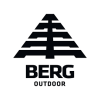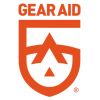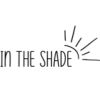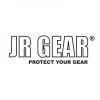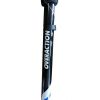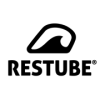Sleeping Bags
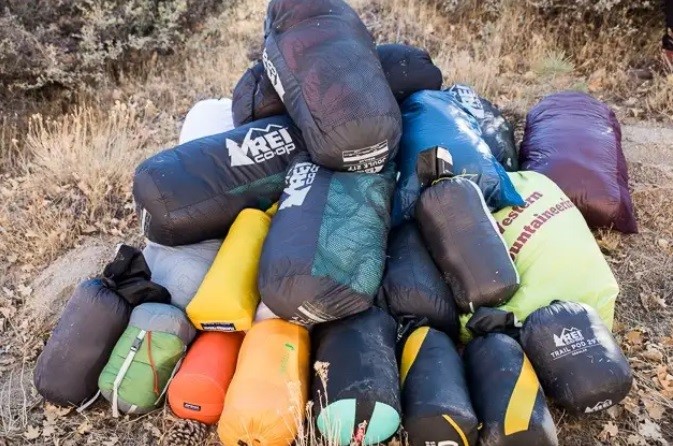
To enjoy a good night's sleep in nature, you need the right equipment. This starts with choosing the right sleeping bag.
Everyone has a different temperature when they sleep, some may sleep warmer than others, men and women are known to have different comfort temperatures, children are probably even more likely to feel the cold, so it is important to choose a sleeping bag that it fits you and will keep you comfortable at night.
What are the different types of sleeping bags?
Sleeping bags differ in many ways, from size (if you are particularly tall you will choose a longer sleeping bag), shape, comfort temperatures, season category, to different types of insulation.
There are mainly 2 different sleeping bag shapes: Square and Mummy.
Square sleeping bags (rectangular or semi rectangular)
These sleeping bags are square at the bottom and sometimes square at the top as well. These sleeping bags give you that cozy feeling you get at home, featuring zips on both the side and bottom so they can be fully opened to turn into a quilt, and you can also clip an identical sleeping bag together to create a double one. Perfect for when you have a bit more space in your luggage, ideal for caravanning or indoor use. While the rectangular shape can give you "homey" comforts, the downside is that you won't get the same level of warmth compared to a mummy-shaped sleeping bag, and you also add more bulk and weight due to the design.
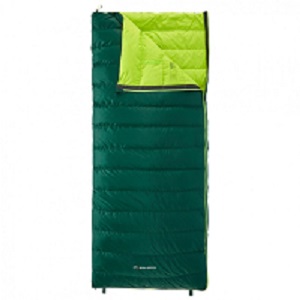
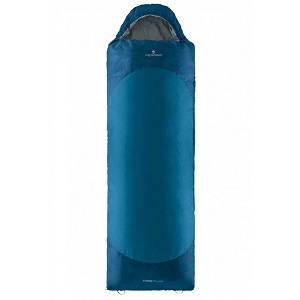
Mummy sleeping bags
This design is best for when you will have a sleeping bag in a backpack. Its shape follows the natural contours of the human body. This shape is better for retaining the maximum amount of heat possible, while also removing excess bulk, reducing the size of the pack for easy portability. It's also worth noting that if you prefer to stretch and move in your sleep, you should probably consider a different design (square). They can range from single-season use (eg. summer) to thick expedition sleeping bags designed for use in sub-zero temperatures.
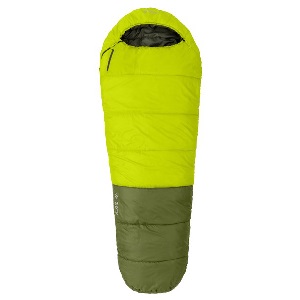
What else to consider when buying a sleeping bag?
When choosing your sleeping bag, consider what time of the year you are camping and whether or not you are more sensitive to the cold. We would recommend comparing different season and comfort ratings for sleeping bags, which can give you a great indication of when the sleeping bag should be used and what temperatures you will find most comfortable when sleeping.
Season ratings and sleeping bag temperatures
Most sleeping bags are rated by season to help you buy the right sleeping bag for the time of year you are camping.
Summer Sleeping Bags – Lightweight with a small volume and ideal for use in the hot summer months (June-August) or for use inside a heated indoor space.
2 Season Sleeping Bags - Ideal for use from late spring to early fall, your standard family camping sleeping bag.
3 Season Sleeping Bags - For early spring to late fall use and maybe a mild winter night.
4-Season Sleeping Bags - Thick sleeping bags, often insulated with down feathers, 4-season sleeping bags are made for use in the winter or when temperatures can drop below zero.
4+ Season Sleeping Bags - These sleeping bags, also known as expedition bags, are intended for use in high mountains and extreme cold temperatures.
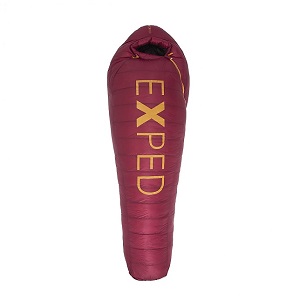
Comfort/extreme temperature rating
Comfort ratings offer the best guide to help you decide whether a sleeping bag is suitable for your own personal body temperature. Sleeping bag manufacturers give us some pointers to know at what temperatures our body will be comfortable, and what are the extreme temperatures that the sleeping bag will protect us from in order to survive. If you find that you are more sensitive to the cold, choose a warmer sleeping bag. Extreme ratings are a measure of survival temperature, but this is simply a guide. Everyone sleeps differently and the difference between the body temperature of men and women at night can be quite significant. Don't be under the impression that you'll be fine because the extreme temperature says so. If you use a sleeping bag in the extreme temperature range, it will be a dangerous night's sleep!
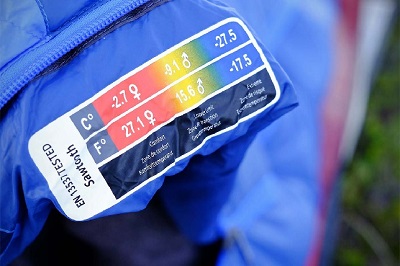
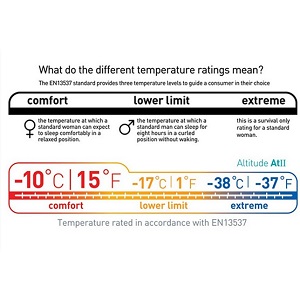
Hood
Much of your body heat is lost through your head, a shaped hood will help you retain heat. A drawstring closure lets you pull the hood tight over your face for added warmth.
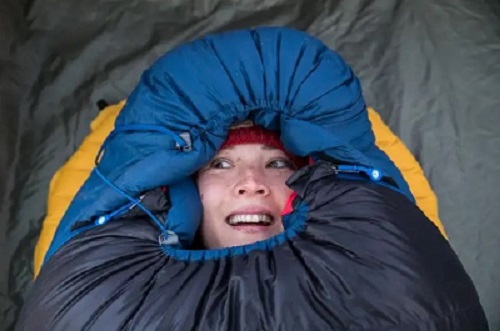
Photo by Caleigh Waldman
Left/Right zipper
You may notice that some sleeping bags will state whether they have a left or right hand zipper. While this may seem like a minor feature, it's actually pretty awkward to zip up a sleeping bag if the zipper is on the wrong side.
Just remember: Left zipper for right-handers, right zipper for left-handers!
It's also worth knowing depending on which side you usually sleep on, it's best to keep the zipper on your back rather than your front for more comfort.
Package Size / Weight
This is generally not a major factor if traveling by car, however, if you are backpacking or just traveling light and need your sleeping bag attached to your backpack for long periods of time, it is worth paying attention to the size of the pack (how small the sleeping bag is when compressed), and weight. For thicker sleeping bags, a compression sack can reduce the bulk of your packed bag. Down sleeping bags are known for their excellent compressibility, so if light pack size is imperative, then a down sleeping bag is best.
Down sleeping bags
Down sleeping bags are the pinnacle of warmth-to-weight ratio, offering impressive warmth in a lightweight, low-bulk design. It is considered by far the best choice for winter expeditions where warmth and weight are the most important things. If you decide to invest, you will reap the benefits for the future. However, down sleeping bags need a lot of care because when they get wet they lose their insulating properties, so it's best to protect them as best you can and treat them with care.
Down sleeping bags have a) different proportions of down feathers and b) different qualities that provide corresponding fill power. The first will tell you the amount of down in the sleeping bag, for example 90/10 will contain 90% down feathers and 10% non-down feathers.
Fill power tells us how "fluffy" the down is, i.e. how much volume it occupies. 600 fill is considered good, 700 is high quality and 800+ is the best and used for winter expeditions in alpine environment.
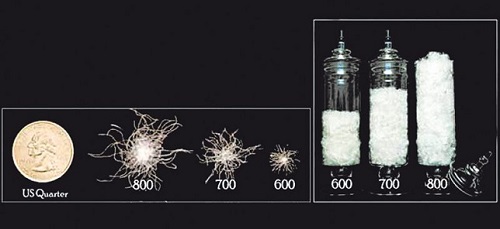
"Fill power" refers to the number of cubic inches that will be covered by one ounce (28g) of down. The higher the number, the more volume the down occupies and therefore the more insulation it provides. The above photo shows the volume difference between 3 different types of down: 600, 700 and 800.
Pros and Cons of down sleeping bags
|
Pros |
Cons |
|
Excellent heat retention |
Loses heat insulation ability when wet |
|
Lightweight- better warmth to weight ratio |
Takes a long time to dry out when wet |
|
Wider comfort temperature range- making it suitable for cold and warm temperatures |
More expensive |
|
Long lifespan if looked after |
Requires special cleaning |
|
Easier to compress and packs small |
|
https://www.mountainwarehouse.com/expert-advice/sleeping-bag-guide/
Synthetic sleeping bags
Synthetic sleeping bags use a synthetic form of insulation to block cooler air from reaching your body. Synthetic insulation is the most common form of insulation in sleeping bags. It is less expensive than down and will be able to retain about 50% of its insulating properties when wet. Synthetic insulation works the same as down by trapping as much warm air as possible. Synthetic and down share the same temperature values, however synthetic tends to weigh more and have a larger pack size.
PrimaLoft

One of the best-known synthetic down companies is PrimaLoft, an American company that produces good quality synthetic down filling for jackets, sleeping bags, shoes, gloves, etc. The idea came from the US military who were interested in a synthetic compound that would be comparable to goose down in weight, compressibility and warmth, but also maintain presence heat. In 1985, the company filed a patent for "synthetic down" and it was finally approved in May 1986.
Primaloft has been proven to provide an equally effective thermal barrier, is of equivalent density, has similar compression properties, has improved wetting and drying characteristics and has superior heat retention when wet!
Pros and Cons of synthetic sleeping bags
|
Pros |
Μειονεκτήματα |
|
Retains insulation when damp/wet |
Does not retain heat as well as down |
|
Cheaper than down |
Shorter life span
|
|
Easier to clean |
|
https://www.mountainwarehouse.com/expert-advice/sleeping-bag-guide/
Sleeping Bag Liners
Sleeping bag liners are a useful addition, as these liners can extend the life of your sleeping bag because they keep the inside clean, meaning your sleeping bag needs to be washed a lot less. A liner can also help keep you warm in colder climates or be used by itself in very hot climates. Sleeping bag liners are available in silk or cotton and can be rectangular or mummy shaped to match your sleeping bag.
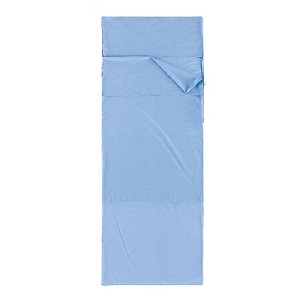
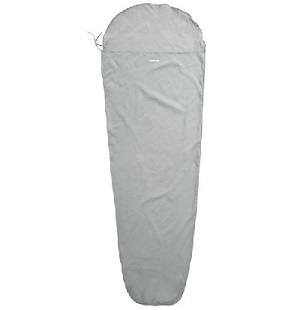
Compression Bags
Sleeping bags can be quite bulky so if you want to save space in your backpack, compression bags can be used to reduce the overall volume of your sleeping bag by about a third. These bags are a good way to add an extra waterproof layer to down sleeping bags. When packing your sleeping bag into your compression sack, it's always best to stuff it randomly rather than roll it up. If you roll the sleeping bag every time, then the filling will always be affected in the same places, which can damage the sleeping bag!
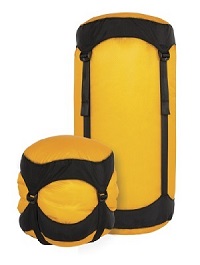
Sources:
https://www.rei.com/learn/expert-advice/sleeping-bag.html
https://www.gooutdoors.co.uk/expert-advice/sleeping-bag-guide
https://www.mountainwarehouse.com/expert-advice/sleeping-bag-guide/
https://www.nytimes.com/wirecutter/reviews/best-sleeping-bag-for-car-camping/
Recent posts
-
24/05/2024Backpack Guide Part Α’ 10 – 30 L
-
20/03/2024Guide for crampons
-
19/02/2024Hangboarding for beginners
-
06/02/2024Rock Climbing in Occupational Therapy
-
23/11/2023Climbing Grades
-
22/11/2023Climbing in psychotherapy
-
16/11/2023What is Bouldering
-
15/11/2023Trad VS Sport Climbing
-
15/11/2023Winter Tents
-
07/11/20233 Season Tents
-
03/11/2023Summer Tents
-
02/11/2023Lifespan Of Your Climbing Gear – Part B Metal Components
-
02/11/2023Lifespan Of Your Climbing Gear – Part A (Harness, Rope, Slings and Webbing)
-
30/10/2023Nail Vernis Aquaglutene - Vade Retro
-
30/10/2023THE LOG BOOK
-
30/10/2023Mountain cookware
-
30/10/2023Our Blog
-
30/10/2023Climbing Shoes - Quick Buying Guide
-
30/10/2023Washing and maintenance of the sleeping bag
-
30/10/2023Superlight Tents
-
30/10/2023ΙNFORMATION FOR CRAMPONS
-
30/10/2023Ice axe
-
30/10/2023INFLATABLE MATTRESS SLEEP
-
30/10/2023Nikwax secrets of waterproofing
-
30/10/2023What Is “Softshell”?
-
30/10/2023Slacklining, ένας εναλλακτικός τρόπος γυμναστικής.
-
30/10/2023Mountaineering - Hiking Boots
-
30/10/2023Waterproof Membranes
-
30/10/2023Sleeping Bags
-
30/10/2023Sleeping Mats
-
30/10/2023Base Layers
-
30/10/2023Climbing Helmets




















